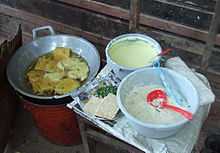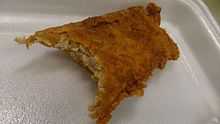Tempeh

Tempeh (/ˈtɛmpeɪ/; Javanese: témpé, IPA: [tempe]), is a traditional soy product originally from Indonesia. It is made by a natural culturing and controlled fermentation process that binds soybeans into a cake form, similar to a very firm vegetarian burger patty. Tempeh is unique among major traditional soy foods in that it is the only one that did not originate from the Sinosphere cuisine.
It originated in today's Indonesia, and is especially popular on the island of Java, where it is a staple source of protein. Like tofu, tempeh is made from soybeans, but it is a whole soybean product with different nutritional characteristics and textural qualities.[1] Tempeh's fermentation process and its retention of the whole bean give it a higher content of protein, dietary fiber, and vitamins. It has a firm texture and an earthy flavor which becomes more pronounced as it ages.[2][3] Because of its nutritional value, tempeh is used worldwide in vegetarian cuisine, where it is used as a meat analogue.
History

Tempeh originated in today's Indonesia, probably on the island of Java. The earliest known reference to it appeared in 1815 in the Serat Centhini.[4] Three detailed, fully documented histories of tempeh, worldwide, have been written, all by Shurtleff and Aoyagi (1985, 1989, and 2001).
Production

Tempeh begins with whole soybeans, which are softened by soaking, and dehulled, then partly cooked. Specialty tempehs may be made from other types of beans, wheat, or may include a mixture of beans and whole grains.
A mild acidulent, usually vinegar, may be added to lower the pH and create a selective environment that favors the growth of the tempeh mold over competitors. A fermentation starter containing the spores of fungus Rhizopus oligosporus is mixed in. The beans are spread into a thin layer and are allowed to ferment for 24 to 36 hours at a temperature around 30°C (86°F). In good tempeh, the beans are knitted together by a mat of white mycelium.
Traditional tempeh is often produced in Indonesia using Hibiscus tiliaceus leaves. The undersides of the leaves are covered in downy hairs known technically as trichomes to which the mold Rhizopus oligosporus can be found adhering to in the wild. Soybeans are pressed into the leaf, and stored. Fermentation occurs resulting in tempeh. [5]
Under conditions of lower temperature, or higher ventilation, gray or black patches of spores may form on the surface—this is not harmful, and should not affect the flavor or quality of the tempeh.[6] This sporulation is normal on fully mature tempeh. A mild ammonia smell may accompany good tempeh as it ferments, but it should not be overpowering. In Indonesia, ripe tempeh (two or more days old) is considered a delicacy.
Nutrition
The soy carbohydrates in tempeh become more digestible as a result of the fermentation process. In particular, the oligosaccharides associated with gas and indigestion are greatly reduced by the Rhizopus culture. In traditional tempeh-making shops, the starter culture often contains beneficial bacteria that produce vitamins such as B12[7][8] (though it is uncertain whether this B12 is always present and bioavailable).[9] In western countries, it is more common to use a pure culture containing only Rhizopus oligosporus, which makes very little B12 and could be missing Klebsiella pneumoniae, which has been shown to produce significant levels of B12 analogs in tempeh when present. Whether these analogs are true, bioavailable B12, has not been thoroughly studied yet.[10] The fermentation process also reduces the phytic acid in soy,[11] which in turn allows the body to absorb the minerals that soy provides.
Preparation
[citation needed]




In the kitchen, tempeh is often prepared by cutting it into pieces, soaking in brine or salty sauce, and then frying. Cooked tempeh can be eaten alone, or used in chili, stir frys, soups, salads, sandwiches, and stews. Tempeh's complex flavor has been described as nutty, meaty, and mushroom-like. It freezes well, and is now commonly available in many western supermarkets, as well as in ethnic markets and health food stores. Tempeh performs well in a cheese grater, after which it may be used in the place of ground beef (as in tacos). When thin-sliced and deep-fried in oil, tempeh obtains a crisp golden crust while maintaining a soft interior—its sponge-like consistency makes it suitable for marinating. Dried tempeh (whether cooked or raw) is more portable and less perishable and may be used as a stew base.
Types
| Name | Description |
|---|---|
| tempe bacem | tempeh boiled with spices and palm sugar, and then fried for a few minutes to enhance the taste. The result is damp, spicy, sweet and dark-colored tempeh. |
| tempe bongkrek | made from or with coconut press cake (see below) |
| tempe bosok (busuk) | rotten tempeh, used in small amounts as a flavoring |
| tempe gembus | made from okara |
| tempe gódhóng | tempeh wrapped in banana leaves |
| tempe goreng | deep-fried tempeh |
| tempe mendoan | thinly sliced tempeh, battered and deep fried quickly, resulting in limp texture |
| tempe kedelai | simply tempeh, made from soybeans |
| tempe kering | raw tempeh cut into little sticks, deep fried, then mixed with spices and sugar, often mixed with separately fried peanuts and anchovies (ikan teri), can be stored up to a month if cooked properly. |
| tempe murni | tempeh made in plastic wrap without any additives such as grated raw papaya (pure soybean cake) |
| tempe oncom (also onchom) | made from peanut press cake, orange in color, with Neurospora sitophila |
A new form of tempeh based on barley and oats instead of soy was developed by scientists at the Swedish Department of Food Science in 2008. It can be produced in climatic regions where it is not possible to grow soybeans.[12]
Tempe bongkrèk
Tempe bongkrèk is a variety of tempeh from Central Java, notably Banyumas regency, that is prepared with coconut. This type of tempeh occasionally gets contaminated with the bacterium Burkholderia gladioli, and the unwanted organism produces toxins (bongkrek acid and toxoflavin) from the coconut, besides killing off the Rhizopus fungus due to the antibiotic activity of bongkrek acid.
Fatalities from contaminated tempe bongkrèk were once common in the area where it was produced.[citation needed] Thus, its sale is now prohibited by law; clandestine manufacture continues, however, due to the popular flavor. The problem of contamination is not encountered with bean and grain tempehs, which have a different composition of fatty acids that is not favorable for the growth of B. gladioli, but encourages growth of Rhizopus instead. When bean or grain tempeh has the proper color, texture and smell, it is a very strong indication the product is safe. Yellow tempe bongkrèk is always highly toxic due to toxoflavin, but tempe bongkrèk with a normal coloration may still contain lethal amounts of bongkrek acid.
Tempe mendoan
A variation of tempeh cooking method, this type is often found in Purwokerto. The origin of the word mendoan is from Banyumas regional dialect, which means "to cook instantly in very hot oil", that results in product cooked on the outside, but raw or partially cooked on the inside, and soft texture. The tempeh is dipped into spiced flour dressing before frying it in hot oil for a short time. Tempe mendoan may seem like half-cooked, soft-fried tempeh, unlike common crisp, fully deep-fried tempeh.
| Wikibooks Cookbook has a recipe/module on |
See also
References
Footnotes
- ↑ Shurtleff, William; Aoyagi, Akiko (2001). The Book of Tempeh. Soyinfo Center. p. 8. ISBN 1-58008-335-8, 9781580083355 Check
|isbn=value (help). Retrieved 6 May 2011. - ↑ Bennett, Beverly Lynn; Sammartano, Ray (2008). The Complete Idiot's Guide to Vegan Cooking. Penguin. p. 17. ISBN 1-59257-770-9, 9781592577705 Check
|isbn=value (help). Retrieved 6 May 2011. - ↑ Dragonwagon, Crescent; Gourley, Robbin (2002). Passionate Vegetarian. Workman Publishing. p. 639. ISBN 1-56305-711-5, 9781563057113 Check
|isbn=value (help). Retrieved 6 May 2011. - ↑ The Book of Tempeh, 2nd ed., by W. Shurtleff and A. Aoyagi (2001, Ten Speed Press, p. 145)
- ↑ Shirtleff, William; Akiko Aoyagi (1979). The Book of Tempeh (PDF). Soyinfo Center, Harper and Row.
- ↑ Mother Earth News. September–October 1977 http://www.motherearthnews.com/Real-Food/1977-09-01/Tempeh-Recipes.aspx
|url=missing title (help). Retrieved 3 January 2013.|coauthors=requires|author=(help) - ↑ Liem IT, Steinkraus KH, Cronk TC (December 1977). "Production of vitamin B-12 in tempeh, a fermented soybean food". Appl Environ Microbiol 34 (6): 773–6. PMC 242746. PMID 563702.
- ↑ Delores D. Truesdell, Nancy R. Green, Phyllis B. Acosta (1987). "Vitamin B12 Activity in Miso and Tempeh". Journal of Food Science 52 (2): 493–494. doi:10.1111/j.1365-2621.1987.tb06650.x.
- ↑ Allison A. Yates. National Nutrition and Public Health Policies: Issues Related to Bio-availability of Nutrients When Developing Dietary Reference Intakes (from January 2000 conference: Bio-availability of Nutrients and Other Bio-active Components from Dietary Supplements.
- ↑ "Vitamin B12: Are You Getting It?". Vegan Health.
- ↑ Amanda Rose. "Soy and Phytic Acid: Stick with Fermented Tempeh and Miso". Reducing Phytic Acid in Your Food: A visual analysis of the research on home kitchen remedies for phytic acid. Rebuild Market. Retrieved 29 December 2011.
- ↑ "New Vegetarian Food With Several Health Benefits". ScienceDaily. May 30, 2008. Retrieved May 2008.
Notations
- Shurtleff, William, and Akiko Aoyagi. 1979. The book of tempeh: A super soyfood from Indonesia. New York: Harper & Row (Colophon Books). ISBN 0-06-091265-0.
- Shurtleff, William, and Akiko Aoyagi. 1985. The book of tempeh. Berkeley, California: Ten Speed Press.
- Shurtleff, William, and Akiko Aoyagi. 1985. History of tempeh: A fermented soyfood from Indonesia. 2nd ed. Lafayette, California: Soyfoods Center. ISBN 0-933332-21-1.
- Shurtleff, William, and Akiko Aoyagi. 1989. Bibliography of tempeh and tempeh products: 1,416 references from 1815 to 1989. Lafayette, California: Soyfoods Center. ISBN 0-933332-47-5.
External links
| Wikimedia Commons has media related to Tempeh. |
| Wikibooks Cookbook has a recipe/module on |
- The Book of Tempeh: Professional Edition – by Shurtleff and Aoyagi (1979).
- Tempeh production: a craft and technical manual – By William Shurtleff, Akiko Aoyagi, Soyfoods Center (Lafayette, Calif.)
- History of Tempeh: A Fermented Soyfood from Indonesia – by Shurtleff & Aoyagi (1985).
- "History of Tempeh"
- "How We Make and Eat Tempeh Down on The Farm" – Mother Earth News, Issue # 47 – September/October 1977
- "How to make tempeh"
- Useful links about tempeh
- "Efficient Tempeh Making with Manfred"
- Making tempeh on a tray using the waterbath method
- An inexpensive incubator for making tempeh
- Easy Tempeh Recipes
| |||||||||||||||||||||||||||||||||||||||||||||||||||||||||||
| |||||||||||||||||||||||||
| |||||||||||||||||||||||||||||||||||||||||||||

